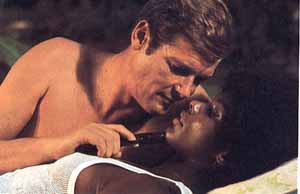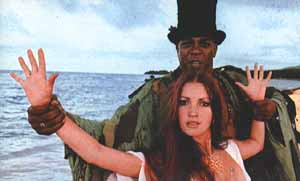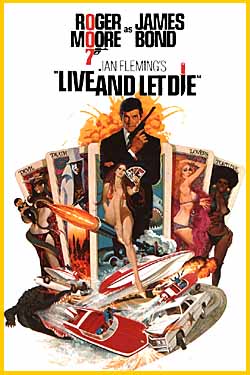|

Yaphet Kotto as Kananga
and Roger Moore as James Bond
in Live and Let Die.
Live and Let Die contains many elements of blaxploitation which have been reversed to accommodate its white protagonist. Blaxploitation often had its black characters sleep with white women. Bond sleeps with the black CIA agent, Rosie, who turns out to be working for Kananga, therefore equating a presumably good black character with villainy. Live and Let Die has most of its action centered in the urban domain of blaxploitation, Harlem and New Orleans. Connections can be drawn between Mr. Big and Super Fly's Priest. However, while Super Fly glorified the drug pusher, Live and Let Die has painted that same figure as evil.

From Live and Let Die.
The question arises, "Was Live and Let Die produced in response to blaxploitation?" This question cannot be simply answered. John Bryson quoted Harry Saltzman, the producer of the Bond films, as saying the similarities were not premeditated. Saltzman said:
Live and Let Die, we decided, would be our next picture after Diamonds Are Forever. This was almost two years before the rash of black pictures started...We began active pre-production seventeen months ago...If I had known two years ago that there were going to be all these black pictures, we would have done Man With the Golden Gun instead of Live and Let Die, because I don't want to be tarred and feathered by that racist syndrome. With the new Bond we are lightening the entire thing. We are not making a picture about blacks per se. We are doing it more tongue-in-cheek, with more humor. (39-40)
Saltzman makes the case that Live and Let Die has nothing to do with blaxploitation but at the same time implies that it is a humorous version of the blaxploitation formula. His remarks are also a bit hard to swallow considering the films blatant appropriation of blaxploitation tropes. The film is littered with pimp mobiles, outrageous dress in the blaxploitation tradition and background music that could have been written by Curtis Mayfield, the music writer for Super Fly.

Geoffrey Holder and Jane Seymour in Live and Let Die.
Saltzmanís use of a time frame to defend the film misses one important fact. While the blaxploitation cycle may in fact have originated with 1971's Sweetback, the social pressures that made it possible predated the film since at least the emergence of the Black Power movement in the 1960s. There are many other films predating Sweetback which also depicted black men as the main protagonists fighting a corrupt system. Ed Guerrero writes:
Broadly taking into account the range of Hollywood productions that generated Blaxploitation and then reabsorbed it, we can loosely sketch these phases as beginning in 1967, with black dissatisfaction with the Sidney Poitier 'star' image and its attendant integration film narrative, which gave way to the rise of the more assertive, macho black athlete film heroes such as Jim Brown and Fred Williamson and black-focused narratives like Cotton Comes to Harlem and Watermelon Man (both 1970). (70-1)
The screenplay for Live and Let Die was written by Tom Mankiewicz who drastically changed the story from Fleming's novel, which is itself profoundly racist. Certainly, social pressures from the Black Power movement and militant figures already on screen were present during the screenwriting. Also, elements such as costumes, scenery and music can safely be assumed to have been created at some time during blaxploitation's early films, if not later.
John Bryson also calls into question Saltzmanís assertions. He writes:
Says one industry observer, "Maybe they didn't plan it on purpose, but it's a reverse Shaft or Super Fly. Instead of a black man's fantasy of a hero stomping white men and screwing white girls in the enormously successful black exploitation pictures, you have a blue-eyes, blond, white knight kicking black men in the face, laying a black girl and others, and riding off into the sunset. There is a gigantic white audience out there, and no one has done a white fantasy in years." (40)
It is clear that this "observer" considers Live and Let Die a "white fantasy." This fantasy presumably involves killing black men, sleeping with black women, and restoring whiteness to a position of power on the screen. All of these presumptions can be directly linked to blaxploitation. His comment that white audiences have not seen a white fantasy in years is no doubt provoked by the explosion of black orientated films. The fantasy aspects of killing black men and sleeping with black women are also linked to blaxploitation's depiction of white evil-ness and white women being subjugated by black men. Bennett and Woollacott speak to the fantasy aspects of the Bond novels saying, "Attempts to explain the appeal of the novels have thus usually been couched in terms of the scope they offer for the gratification of repressed desires or for the realization, by proxy, of otherwise unattainable pleasures" (15). While they go on to offer additional explanations of the novels' appeal, this explanation is pertinent to this discussion of the film. The repressed desires that are fulfilled in Live and Let Die are those revolving around white dominance of minority cultures and the indomitable power of white hegemony. In reality, these desires are not repressed and have been the order of business in this country for hundreds of years. However, in light of liberal attitudes circulated in this country in recent history, these white desires are not allowed to be openly voiced except through radical right-wing mouthpieces. Live and Let Die allows these semi-repressed desires to be openly voiced, enacted and shared by the white spectator, after all, all the black characters are bad anyway (a logic legitimized by Saltzmanís comments). However, the co-optation of blaxploitation aesthetics and themes in Live and Let Die directs these fantasy desires at the black militant figure in blaxploitation, and therefore to the Black Power movement and its refusal to assimilate.
page 4 of 5
 
You can move through the article by selecting "next page," or you can go to a specific section of the article by using the links below. In addition, you can check out our selection of links for blaxploitation Web sites.
Chris Norton received his B.A. in English and Film Studies from Oakland University, Rochester, Michigan and an M.A. from New York University in the Department of Cinema Studies. Chris welcomes comments or questions about his article. You can reach him at norteiga@aol.com.
|


 Live and Let Die: Bring on the Black Guys
Live and Let Die: Bring on the Black Guys










